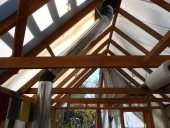paul wheaton wrote:
I sent Erica an email and got an auto responder saying that she'll be in canada, teaching a rocket stove class, until the 13th.
Ah, but I have a 5-hour layover in Buffalo, and a Laptop. (Well, technically right now I haven't left yet.)
Building right onto a compacted gravel pad works pretty well. Especially if you are then going to lay an earthen floor, and can therefore sink the burn tunnel a little bit under the floor. You can get extra height on the heat riser, and still have the top of the barrel at a comfortable height for heating a kettle.
Check out a new slideshow I put up on Picasa for this upcoming workshop. There are several stove projects in it. One of them shows a method for insulating underneath the burn tunnel by creating a brick box full of perlite, then laying the brick floor of the burn tunnel on top of that. This insulation is optional - it tends to keep a little more heat in the system and not the ground.
http://picasaweb.google.com/eritter There are also a couple of pictures of the junction between barrel (flue gas) and heat-exchange ducting. We call this the "manifold."
There's one in the first step-by-step where we used a metal fitting we found in a scrap pile, and toward the end there's a picture of a dry-fit version of a "brick beehive." Ianto prefers a deep dropout "ash pit," with a cleanout, and then just let your pipe pick up at the other end. Basically, create a space that connects the opening at the rim of the barrel, and the opening of your pipe.
It is the trickiest thing to explain, or to wrap your brain around, but the good news is you create almost any solution and it will work. (DO apply a little common sense - maintain the cross-sectional area of the opening, and leave room for ashes or a user-friendly cleanout.)
Cleanouts - the beauty of using T-joints is that they often come with caps. You can see these in the slide show too. You can also improvise almost anything. The flue gas heat is in the 100-400 degree range, most metal fittings or even a wooden lid will work. People who like plastering sometimes embed a string "coil" that they can pull to rip out that section of plaster, like a wrapper on a pack of gum.
We did ours with capped T-joints, and covered those with a hollow, plastered-in-place tile. We left a little corner where you can get your fingers in there to pop the tile out, and set it back in. So there's a nice air gap to keep the surface temperature down, a nice metal fitting to contain the flue gas, and a fun secret panel to show our guests that looks pretty when not in use. Only down side so far: small children drumming their heels on it while sitting on the edge of the bench.
We've seen cleanouts made of cut-off paint cans (the lid facing outward), but if you get too creative people sometimes get curious and pry them off to see why there is a paint can in your cob bench. Then when you go to light the stove, you discover the lid is missing and there's smoke in your house.
So we tend to go with subtle, or screw-on / plaster-on fittings that are harder for visiting monkeys to mess with.
If you know anybody in Toronto / NY / Vermont who wants a wild experience this weekend, send 'em out to Flesherton to join our workshop. There's still room, and not too many people seem to know about these things out there.
http://www.naturalbuild.ca/rocketstove.html Thanks,
Erica


































































